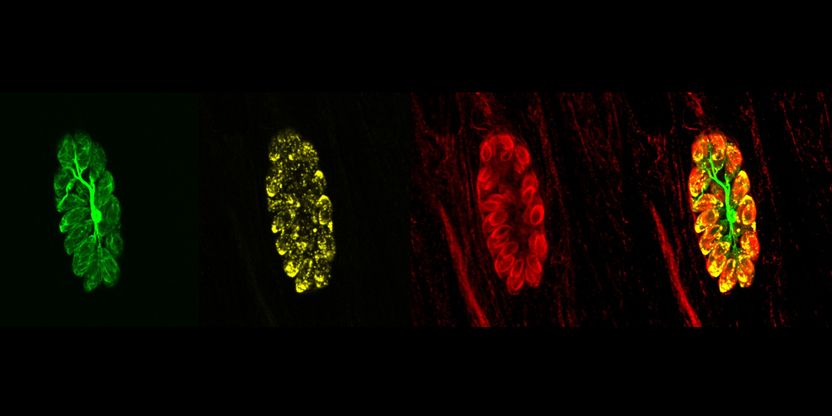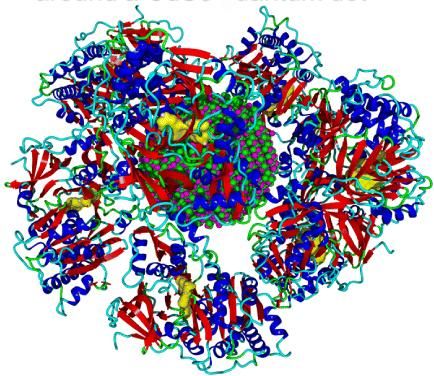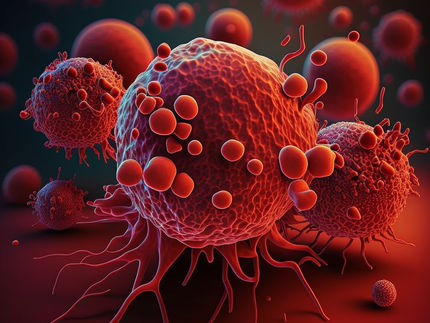Toxoplasmosis: propagation of parasite in host cell stopped
A new method blocks the protein regulation of the parasite Toxoplasma gondii and causes it to die off inside the host cell
toxoplasmosis is one of the most widespread zoonoses worldwide. It is an infectious disease that can be transmitted from cats to humans. People can also become infected by consuming raw or undercooked meat. Infection is particularly dangerous for pregnant women, as it can cause fetal deformities.

Vacuole in host cell: The small daughter cells inside the cell are connected with each other via a network, somewhat akin to an umbilical cord.
© Yuan Song / LMU
The cause of the disease is the single-celled parasite Toxoplasma gondii. Inside the host cell, it forms a little bubble-like compartment called a parasitophorous vacuole, which facilitates nutrient exchange and synchronized cell division. The resulting daughter cells are connected with each other inside the vacuole via a network, somewhat akin to an umbilical cord. Up to 64 daughter cells can form in the compartment. As soon as the offspring are mature, a regulation mechanism prompts the dissolution of the vacuole and the structures that have formed inside it. This is the moment at which the daughter cells become mobile and invade new host cells.
Hope for the development of new drugs
Before now, it was not known which genes encode the proteins that control the exit from the host cell. To identify them, a team led by Prof. Markus Meißner, Chair of Experimental Parasitology at LMU, collaborated with colleagues from the University of Glasgow in Scotland to develop a novel genetic screening technique, which is based on the Cas9 “genetic scissors,” and investigate a library of 320 parasite-specific genes. They discovered two genes without which cell egress is impossible.
The targeted destruction of these genes led to a blockade of the egress and thus to the death of the next generation of parasites within the host cell. “This paves the way potentially for the development of active substances that could block the function of the corresponding proteins and so put a halt to propagation,” observes Markus Meißner.
Toxoplasma gondii is closely related to the malaria pathogen Plasmodium falciparum. Therefore, the parasite serves as a model organism for the pathogen of the tropical disease, which kills hundreds of thousands of people worldwide every year. “We assume that similar processes control the propagation of the malaria pathogen,” explains LMU parasitologist Dr. Elena Jimenez-Ruiz. “Next, we will investigate what functions these proteins have in the malaria pathogen and whether there are possible starting points for the development of new drugs.”
Original publication
Other news from the department science

Get the life science industry in your inbox
By submitting this form you agree that LUMITOS AG will send you the newsletter(s) selected above by email. Your data will not be passed on to third parties. Your data will be stored and processed in accordance with our data protection regulations. LUMITOS may contact you by email for the purpose of advertising or market and opinion surveys. You can revoke your consent at any time without giving reasons to LUMITOS AG, Ernst-Augustin-Str. 2, 12489 Berlin, Germany or by e-mail at revoke@lumitos.com with effect for the future. In addition, each email contains a link to unsubscribe from the corresponding newsletter.
Most read news
More news from our other portals
Last viewed contents

Process Reactors | Prozessreaktoren | Dunn
Kidney_(Zang)
Liu_Zi_Jue






















































